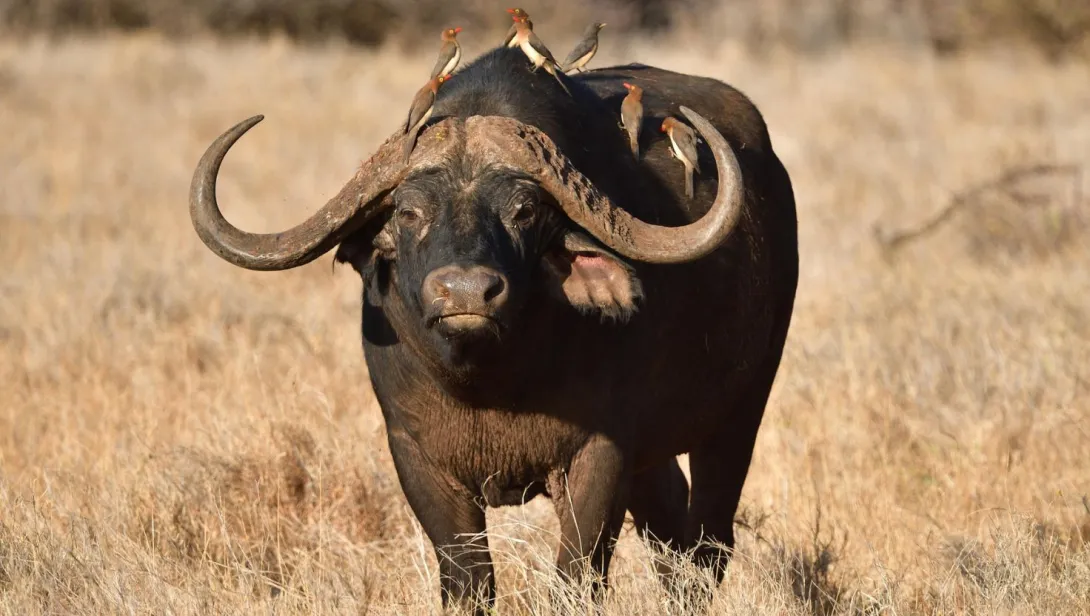Skip to main content
Introduction
- The African Cape Buffalo (Syncerus caffer) is one of the most formidable and dangerous animals in Africa.
- They are known for their large, robust bodies, curved horns, and unpredictable behavior.
- Cape Buffalos are part of the Big Five and are highly respected by hunters and wildlife enthusiasts.
Physical Characteristics
- Cape Buffalos have a massive, stocky body, with males weighing between 1,100 to 2,200 pounds (500 to 1,000 kg) and females slightly smaller.
- Their coat is dark brown or black, with older males having a thick, armor-like skin on their necks and shoulders.
- They have large, curved horns that form a continuous bone shield over the top of their heads.
- Cape Buffalos have strong legs and hooves, which help them navigate rough terrain and defend against predators.
Habitat and Distribution
- Cape Buffalos are found in sub-Saharan Africa, including countries like Kenya, Tanzania, and South Africa.
- They inhabit a variety of environments, including savannas, grasslands, swamps, and forests.
- Cape Buffalos are highly adaptable and can thrive in both wet and dry habitats.
Diet and Foraging
- Cape Buffalos are herbivorous and primarily feed on grasses, leaves, and shrubs.
- They are grazers, spending most of their time feeding on grasses, especially during the wet season.
- Cape Buffalos consume up to 2% of their body weight in food daily.
- They are dependent on water and need to drink daily, which influences their movement patterns.
Behavior and Communication
- Cape Buffalos live in large herds that can range from a few individuals to over a thousand.
- They communicate through vocalizations such as grunts, growls, and bellows, as well as through body language.
- Cape Buffalos are highly social animals, with strong bonds within the herd.
- They are territorial and will defend their territory and herd members aggressively against predators.
Reproduction and Lifespan
- Female Cape Buffalos give birth to one calf after a gestation period of about 11.5 months.
- Calves are born weighing around 65 to 100 pounds (30 to 45 kg) and are cared for by their mothers.
- Calves stay with their mothers for up to 2 years before becoming independent.
- Cape Buffalos have a lifespan of 15 to 25 years in the wild and up to 30 years in captivity.
Conservation Status
- Cape Buffalos are classified as Least Concern on the IUCN Red List, with stable populations in protected areas.
- They are threatened by habitat loss, human-wildlife conflict, and diseases like bovine tuberculosis.
- Conservation efforts include protected areas, anti-poaching measures, and disease control programs.
Unique Adaptations
- Cape Buffalos have thick, armor-like skin on their necks and shoulders, which protects them from predators.
- Their large, curved horns are used for defense and dominance displays within the herd.
- They have excellent hearing and sense of smell, which help them detect predators and other threats.
- Cape Buffalos are highly aggressive when threatened and will charge at predators, including lions and humans.
Cultural Significance
- Cape Buffalos are revered in many African cultures as symbols of strength, resilience, and power.
- They are featured in mythology, literature, and art across Africa.
- In some cultures, Cape Buffalos are considered spiritual guides and protectors.
Fun Facts
- Cape Buffalos can run at speeds of up to 35 mph (56 km/h).
- They are highly social animals, often seen in large herds that provide protection against predators.
- Cape Buffalos are known to kill lions and other predators when defending themselves or their herd.
- They are keystone species, playing a crucial role in maintaining ecosystem balance by shaping vegetation.
- Cape Buffalos have poor eyesight but excellent hearing and sense of smell.
- They are not true buffalo but are more closely related to cattle and bison.
Threats to Cape Buffalos
- Habitat loss due to agriculture and urbanization is a major threat to Cape Buffalos.
- Human-wildlife conflict often results in Cape Buffalos being killed by farmers protecting crops.
- Diseases like bovine tuberculosis and foot-and-mouth disease are significant causes of their decline.
- Climate change is altering their habitats, making it harder for them to find food and water.
Conservation Efforts
- Protected areas and wildlife reserves have been established to safeguard Cape Buffalo habitats.
- Anti-poaching initiatives and stricter wildlife protection laws have helped reduce illegal hunting.
- Disease control programs help prevent the spread of diseases like bovine tuberculosis.
- Global awareness campaigns highlight the importance of Cape Buffalo conservation and encourage public support.
